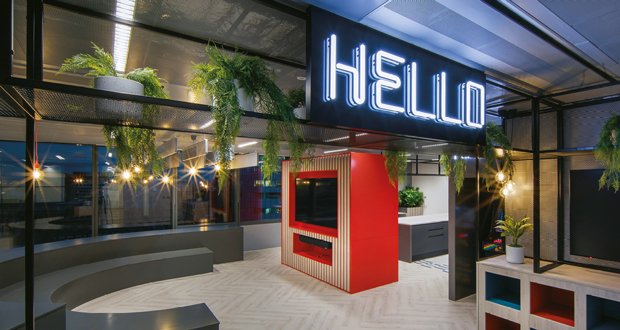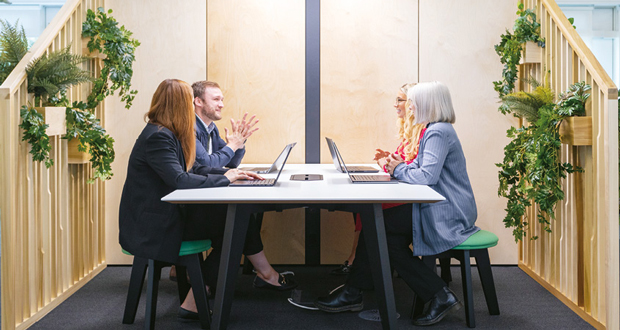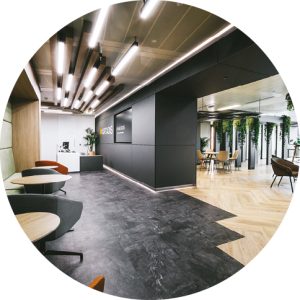DISPELLING GENERATIONAL STEREOTYPES
To truly understand what employees need from the workplace, it’s important to dispense with stereotypes, especially when it comes to the four major generations in the workplace – Generation Z (Born 1997 onwards), Millennials (Born 1981-1996), Generation X (Born 1965-1981) and Baby Boomers (Born 1946-64).
The research shows that Baby Boomers have the highest desire for face-to-face collaboration opportunities in the office (40 per cent) while Generation Z-ers have the greatest need for access to events to feel closer to employers (40 per cent). It’s the Millennials who are most in search of social occasions (39 per cent) and Generation X who want to form friendships and have opportunity for skills and development (both 35 per cent).
We all fall into the trap of generalising to some degree, but stereotypes can be unhelpful, especially when it comes to shaping the employee experience and designing the workplace.
Out of all the generations, it is Generation Z-ers, the youngest in the workforce, who are most proud of their workspaces (8 per cent). This might seem surprising as they’re often considered most likely to embrace all things digital, including remote working.
It’s this generation that’s often without an ideal work space at home – perhaps they’re still living with parents or they’re in a noisy flat share. This generation is also the most likely to visit the office to benefit from heating, which is a sure sign of the times with cost-of-living increases – plus they expect environmentally responsible behaviours such as improved recycling and EV charging, and want the workplace to help them develop friendships and social ties. They are demanding and highly in tune with how they want work to make them feel.
At the other end of the spectrum are Baby Boomers who have spent the vast majority of their lives in very static desk-based office environments and are often viewed as ‘technophobes’.
Yet contrary to the stereotype, Baby Boomers said better technology in the office to improve collaboration would make the office more inviting (24 per cent), while 40 per cent want more face-to-face collaboration opportunities from the office. Also it’s team work that makes Baby Boomers feel the most positive in the workplace – followed by seeing friends and being able to get their best work done. This generation is all about connection and productivity.
ENSURING WORKPLACES RESPOND
Set against the backdrop of distinct generational wants, it’s important to remember that there are common feelings that unite them as one homogenous workforce. For FMs to reflect this in the workplace, there are some useful tips to ensure buildings respond appropriately.
- Understand how work is really done
It’s important to understand an organisation’s workflow – that is how work gets done and information and tasks flow through the business. Is it that tasks flow through all departments quickly or does the organisation have a more project-based methodology, with project teams working to set deadlines? Once you understand how work flows through a business you can start to identify what it requires of space and facilities. This is a process we often call workplace consultancy as it ties wants and needs together with more observational usage and behavioural studies. For FMs not able to commission workplace consultancy, there is still a lot to be gained from standing in the shoes of your employees and moving through a workspace as different tasks are completed. This will identify areas of friction and help to improve the employee experience. - Reframe Facilities
Think about facilities from the position of how they make employees feel – if technology leaves employees unproductive and frustrated it needs revisiting. If demand for meeting rooms is so great that people are being turned away, then you need to provide more support. If there aren’t quiet spaces for people to join video calls or focus on concentrated work, they need to be added. If you’re not offering spaces that suit those with neurodivergent needs, those who are experiencing menopause or those who have faith requirements – these need to be included. Many of these considerations are not new to the FM role, but instead of thinking of them as facilities that impact efficiency, view them as opportunities to improve feelings and therefore wellbeing, positivity and productivity. - Offer Choice and Personalisation
One of the biggest legacies from COVID is that people want to determine how, when and where they work. When employees can personalise their own workplace experiences by choosing which spaces and facilities they use, it makes them feel more positive and productive. Choice needs to be plentiful – from great tech to ensure parity of experience for in-person and remote meeting attendees, through to great refreshments, thoughtful areas to relax and spaces that suit the most quiet and studious of tasks as well as the most collaborative teams. Choice creates a sense of control and in turn makes the workplace more inclusive.
The real value of this research is that it’s highlighted that employees want to feel good about their work and themselves while they’re doing it.
This means workplaces need to cater for employees’ emotional needs and actively help them feel happy, healthy and more productive as well as meet their more practical task-based needs with systems and technology. The remit of FMs has expanded massively in recent years. Now there’s a huge opportunity for facilities professionals to really embrace how employees feel and to use these insights to curate, deliver and manage the very best workplace experiences.
To read Claremont’s Workplace Oooh Report in full, visit: www.claremontgi.com/the-workplace-oooh/







